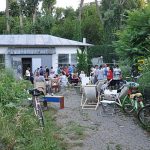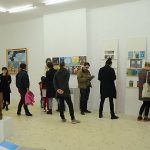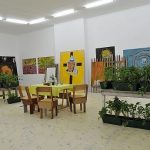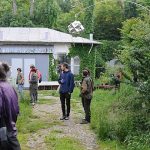Text: Iuliana Dumitru
These days there are two years since I first set foot in the space of tranzit.ro/București. I got there on a drizzling rain, not knowing much about the place, although it had been in the city for over three years. Once past the gate with many locks, I realized right away that everything I knew about a conventional art space was not applicable in that case. What do you mean, organizing exhibitions and growing vegetables in the same place?
After a lengthy discussion with RalucaVoinea, the curator of the space, I understood that the responsibility she felt for the place would not let her develop the exhibition space without also developing the garden in front of it. I left, delighted with my new discovery, and carrying two pounds of tomatoes in my bag. After I finished eating the first salad, I sent her this message: “If possible, for next year, I would like a plot of my own in the community garden.” The reply popped up immediately: “We’ll be happy to, you’re welcome”. In less than a day, I was a member of the garden and I would be part of a community of people cultivating land and enjoying its produce together.
Garden working sessions and meals have become a tradition over time. Everything that would be planted is decided upon here. Decisions are always made together, and most of what sprouts up in the garden is shared among us. These meetings enhance the feeling of belonging to the space and strengthen the connections between the members of the community. Ever since the beginning, the garden and the manner of growing things here, have observed the rules of permaculture. Eduard Constantin, Ionuţ Bădică, and Athena Dumitru are the basic pillars of the garden. Edi is an artist, the one standing by Raluca ever since the beginnings of the tranzit Bucuresti Space, Ionut is one of the initiators of the permaculture movement in Romania, and the Tranzit Garden was one of the first spaces to experiment community urban permaculture, and Athena – the magic fairy – has imagined and developed the back-yard garden, where a (variable) quantity of cats is also present nowadays.
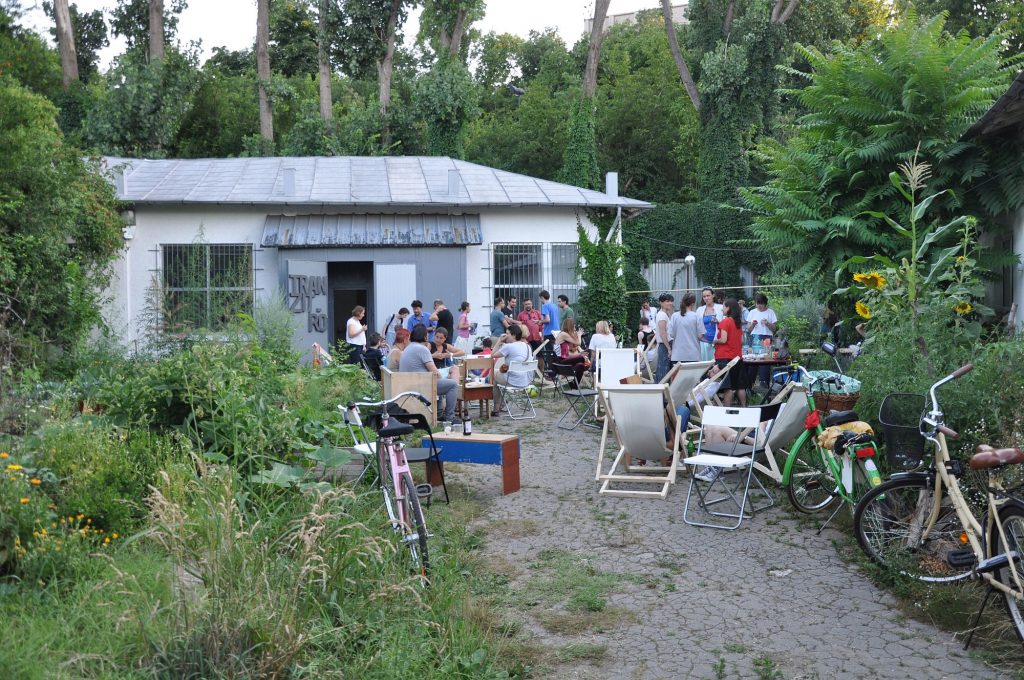 *© Raluca Voinea
*© Raluca Voinea
“This street really shows the general tendency to retreat into private space; look how everybody builds fences as high and opaque as possible… Our public generally comes by bicycle or with public transport and the space has permeating borders and openness towards a large series of public spheres.” – Raluca Voinea, 2014
The garden managed to bring together people from different backgrounds, however, artists are preponderant (although a minority in the first year). This makes the space look truly special: at the entrance, on the left hand, there is the water tower of artists Olivia Mihălţianu and Stoyan Dechev, the installations inspired by architect Yona Friedman make way between rows of onions, and not least, the “star” of the garden – the Solar Flower of artist Pavel Braila, already known for its hypnotic power.
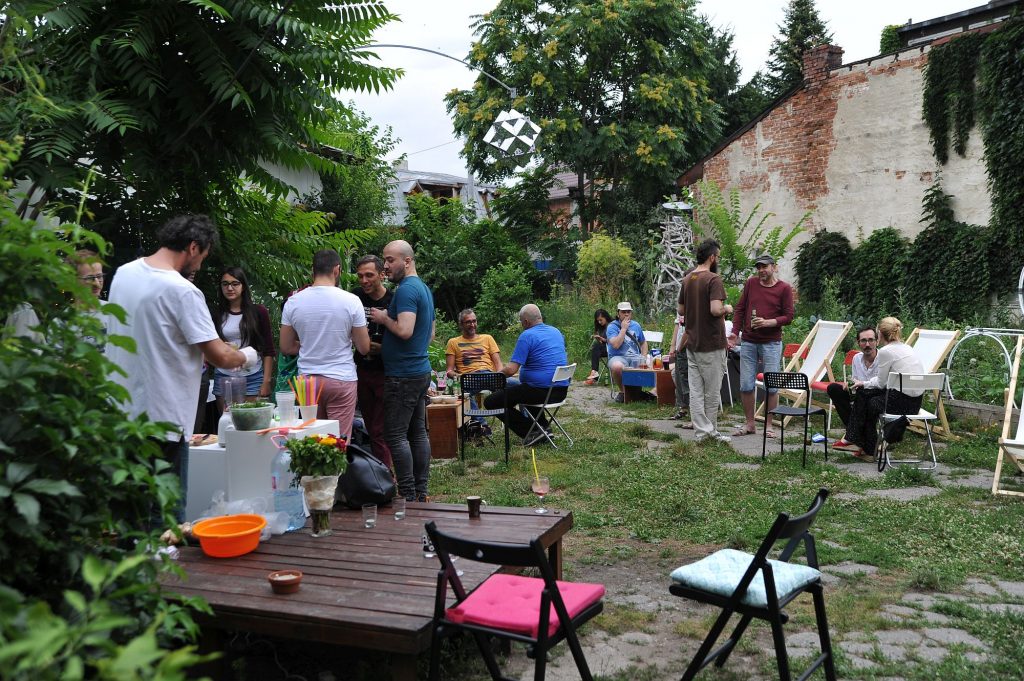 *photo: Valentin Florian Niculae, 2017
*photo: Valentin Florian Niculae, 2017
The tranzit.ro orangery, the smaller building in the same yard, was renovated to become a place dedicated to the garden and to the events that very broadly approach the topic of “natural”. In a corner, there is a small showcase of organizational plans and “treasures” found during work, and on top of it, a few images of the beginnings of the garden. It is only when I look at them and compare, that I realize the amount of energy and time invested to make everything look as it does. It is worth appreciating that, although the space is a “developed” one, it has still preserved its natural allure. Spontaneous flora is important for the garden, so important that is has become a subject of study. Professor Ioana Georgescu, Ph.D., from the Faculty of Horticulture, offered us, this spring, a lecture on the spontaneous plants in the garden. The plants have given us precious clues on the nutrients in the soil, its humidity and fertility.
The garden has the quality of being a place of transition between an everyday environment, namely the street, and an extra-ordinary one, namely the exhibition/art space. It was not infrequently that the two environments intertwined in such a way, that the garden entered the exhibition, and art came out into the garden. Yuri Leiderman (b.1963, Odessa, Ukraine) exhibited his work at tranzit.ro/București between 5.09.2017-5.11.2017- “Self-Portrait in Valerian”. His exhibition combined the two environments – art and nature. It is precisely around this harmonious combination of art and nature that the identity of the tranzit.ro/București space is configured, offering it a unique character as compared to other spaces in the city.
 *Yuri Leiderman exhibition, September 2017. Photo: Valentin Florian Niculae
*Yuri Leiderman exhibition, September 2017. Photo: Valentin Florian Niculae
At the same time, tranzit.ro/București can be called a public space, although it does not observe the classic definition of one. Its occupation is made based on a schedule, however, it remains open and accessible and there is a complete lack of the commercial hijacking that now takes place everywhere in Bucharest. One can say that tranzit.ro/București is neither a private, nor a public space, it is a mixture of the two, an intermediate space, always between the two spaces, a place at the crossroads. This was also my first feeling of the place, that I had crossed the threshold of an intermediate place, that I was no longer in easily catalogued territory.
 Lecture in the garden of curator Charles Esche; photo: Iuliana-Dumitru
Lecture in the garden of curator Charles Esche; photo: Iuliana-Dumitru
I noticed that, like myself, people reaching this place for the first time have either come to see an exhibition, a play, or take part in a workshop, book/magazine launch, have the same reaction: “Wow, I had no idea there was such a place in Bucharest!”, this being a normal reaction, considering the special energy of the place. I also believe that this is a counter-reaction to everything going on in the city, to the was public space is constructed or de-constructed. The space at tranzit.ro/București ends up being seen as an oasis of tranquillity in a city suffocated by cars and extremely noisy, an aggressive city that does not provide any refuge. The city where the authorities are selling out every place larger than a few square feet, where visual aggression is at a maximum (and I mean here especially the city centre), and the traffic that is suffocating in its truest sense, leads to the public running away from the public space.
In this context, tranzit.ro/București is attempting to create a space that is open to a diverse public, and in my opinion it manages to do so through a varied program and a lot of opening. One year after my first visit, I was a certified regular, holder of a business card: assistant curator. Who would have through that a bag of delicious tomatoes would land me my “dream job”? You are welcome to visit us, in strada Gazelei, 44.
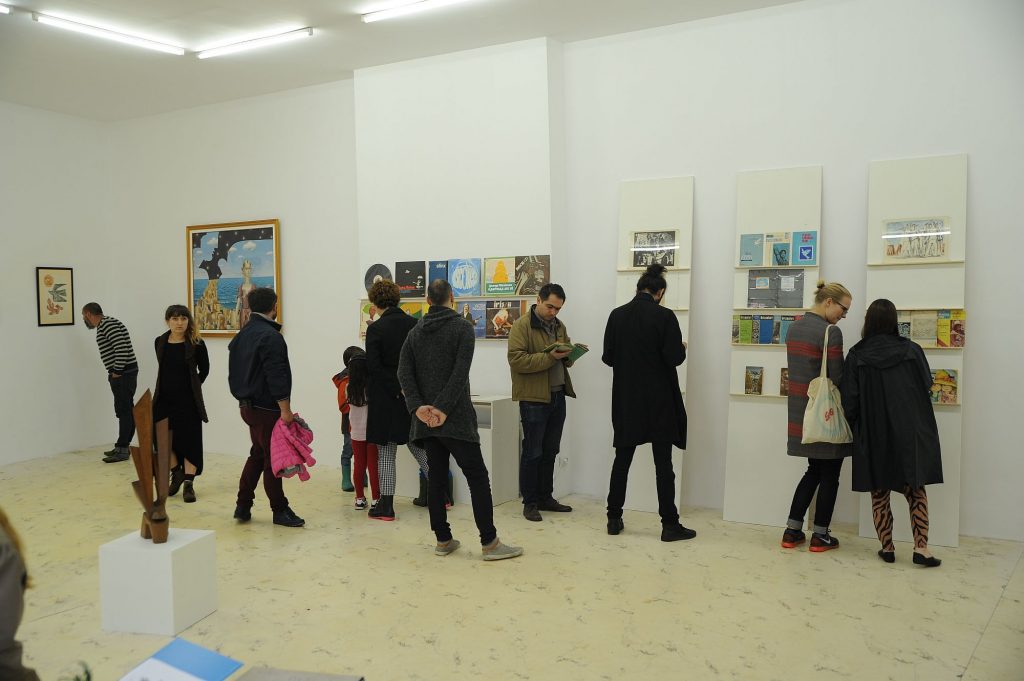 *The Veil of Peace Exhibition, 2017. Photo: Valentin Florian Niculae
*The Veil of Peace Exhibition, 2017. Photo: Valentin Florian Niculae
tranzit.ro was founded in 2012 at the initiative of ERSTE Foundation, becoming thus the fifth member of tranzit.org, a network of independent, non-profit organisations in Austria, the Czech Republic, Hungary and the Slovak Republic.
tranzit.ro has the particularity of being itself a network, activating in three permanent spaces in the cities of Iasi, Cluj and Bucharest. In Bucharest, the innovative platform dedicated to contemporary art functions in a former atelier and repair shop, also used as an archive building and at one point, as an accomodation for seasonal immigrant workers. ERSTE Foundation is the main partner of tranzit.ro

